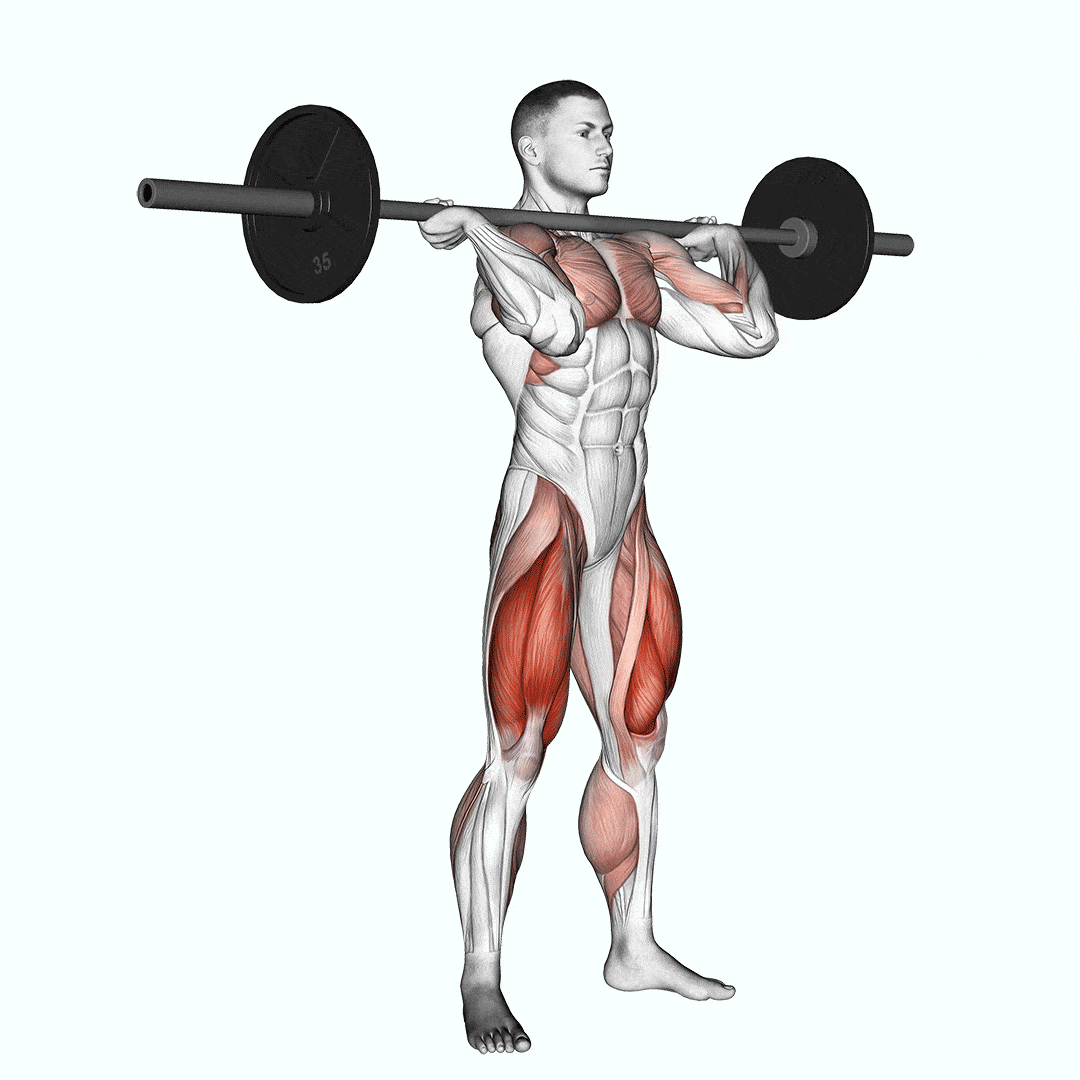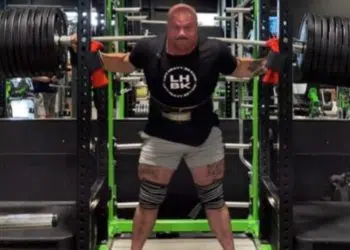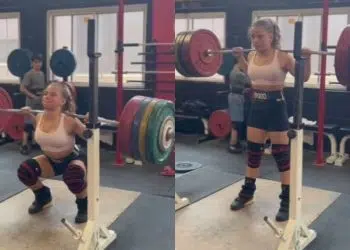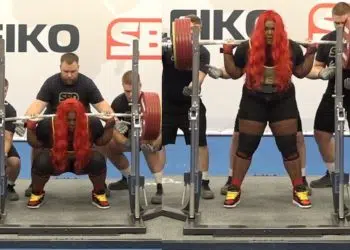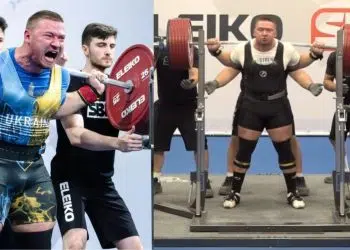Overhead presses and squats are two of the best exercises to build strength and muscle mass; the squat jerk delivers a bang for your buck by combining the two.
Olympic weightlifting has three styles of jerks that rely on different receiving positions — power jerk (or push jerk), squat jerk, and split jerk. The squat jerk is the rarest because of its mobility demands, making it unsuitable for most athletes. However, it is widely popular with the Chinese Olympic weightlifting team.
Due to its technical difficulty, executing the squat jerk safely demands exceptional mobility, core strength, and stability.
In this article, I take you over how to perform squat jerks with the correct form, their benefits and drawbacks, the muscles worked, and the most prominent squat jerk variations and alternatives.
How to Do a Squat Jerk: A Step-By-Step Guide
To explain every nuance and detail tied to the proper squat jerk technique, I broke the exercise into five simple steps. Remember, you must warm up adequately before performing squat jerks to improve your performance and reduce the risk of injury.
Step One — Get the Barbell Into the Front Rack Position
There are two ways of getting into the front rack position. First, clean the barbell to your shoulders. Or you could use a squat rack. For the sake of this tutorial, we will stick to the squat rack. So, the first step is to load the barbell on the squat rack. Then, grab the barbell with a wider-than-shoulder-width grip, stand upright, and brace yourself for the next step.
Level Up Your Fitness: Join our 💪 strong community in Fitness Volt Newsletter. Get daily inspiration, expert-backed workouts, nutrition tips, the latest in strength sports, and the support you need to reach your goals. Subscribe for free!
Pro Tip: People with excellent overhead and hip mobility can use a slightly wider than shoulder-width grip, whereas people who lack overhead mobility should use a much wider grip.
Step Two — Dip (Flex Your Hips, Knees, and Ankles)
After assuming the correct starting stance, the next step is to dip your legs by flexing your hips, knees, and ankles slightly. This is the same as entering an athletic quarter squat position. Move your knees outward over your toes, and make sure your hips travel straight down. Lastly, when performing these movements, keep your chest up.
Pro Tip: You should move your knees outward because pushing them straight ahead or caving them in can lead to undue stress on the ligaments, especially the anterior cruciate ligament (ACL), increasing the risk of potential injury.
Step Three — Drive
Once in the dip, you must carefully but quickly reverse the movement by aggressively performing triple extension, which includes extending your ankles, knees, and hips simultaneously. This movement should effectively drive the bar upwards towards the ceiling.
As you execute this, your heels should momentarily lift off the ground, emphasizing the force and power of the drive phase. This heel action is crucial as it ensures maximum force transfer from the legs to the bar.
Pro Tip: Beginners should perform this exercise with a wider-than-hip-width stance, whereas experienced lifters can use the upward momentum to widen their stance during the drive phase.
Step Four — Receiving
Explode the bar towards the ceiling by flexing your shoulders and extending your elbows. After driving the bar toward the ceiling, it’s time to tuck underneath it and catch it in the deep squat position. Start by transitioning to the deep squat position with your arms fully extended overhead. Land your hips between your heels to maintain a balanced and upright torso.
Pro Tip: Keep your elbows locked out and look straight ahead.
Step Five — Recovery
Once stable in the bottom squat position with the barbell overhead, extend your knees and hips to stand up. Stand up slowly and avoid shifting the weight of the barbell since that can result in loss of balance.
Pro Tip: Watching professional weightlifting competitions can immensely benefit mastering this lift. Observing the techniques and postures of seasoned lifters can provide valuable insights and cues to enhance your technique.
Squat Jerk Tips:
Get the most out of your squat jerks with these tips:
- Master the Footwork: Ensure your foot positioning is correct. Start with your feet hip-width apart and your toes turned out slightly. Always experiment with your foot placement to find the position that suits you the best and allows you to squat deep.
- Core Stability: To perform squat jerks effectively, you must have adequate core strength and stability. Keep your core braced throughout the lift.
- Smooth and Controlled Descent: When you receive the barbell in the deep squat position, focus on a controlled and smooth descent. Avoid lowering too quickly since this can lead to instability and missed lifts.
- Overhead Mobility: Mobility exercises during warm-ups and cooldowns are one way to boost your overall overhead mobility.
Benefits of Squat Jerk
Below are the advantages of adding squats jerks into your routine:
Improved Movement Efficiency
Compared to other jerk variations, squat jerk is an economical lift since the bar doesn’t need to move as much. Every lifter needs to execute heavy and dynamic movements with precision. Squat jerks will ensure exactly that, as you must get under the bar to shorten the distance the bar has to travel.
Increased Leg Strength
Squat jerks will increase your leg strength and power, which is crucial for every serious weightlifter.
Enhanced Core Strength
Squat jerks will effectively increase your core strength by strengthening the rectus abdominis, obliques, glutes, hips, and transversus abdominis.
Increased Overhead Strength and Stability
Squat jerks are excellent for increasing the strength and stability of your shoulders, upper back, and scapular complex. The overhead position requires traps, infraspinatus, supraspinatus, and additional shoulder muscle mobility and stability, dramatically enhancing intermuscular coordination. [1]
Improved Total-Body Coordination
Any movement that requires multiple limbs, muscles, or joints to work together will likely improve your total body coordination.
Increased Speed
Squat jerks are defined by speed and power, meaning they are excellent for developing those traits as well. You must move quickly between different positions to complete the lift successfully.
Improved Mobility
Mobility plays a significant role in performing squat jerks correctly. Practicing this exercise can improve your overhead mobility.
Level Up Your Fitness: Join our 💪 strong community in Fitness Volt Newsletter. Get daily inspiration, expert-backed workouts, nutrition tips, the latest in strength sports, and the support you need to reach your goals. Subscribe for free!
Drawbacks of Squat Jerk
Here are the disadvantages of the squat jerk:
Technical Complexity
The squat jerk is a complex exercise with multiple movements and positions, making it unsuitable for most lifters. You must first learn how to effectively do overhead squats and jerks separately.
Greater Risk of Injury
Performing this exercise without an incorrect form increases your risk of injury. You must warm up properly and improve your overall mobility to improve your weightlifting performance.
Mobility Requirements
You need decent mobility to perform squat jerks. Most exercisers cannot execute this movement correctly on their first attempt.
Muscles Worked During Squat Jerks
Squat jerk is a full-body movement. Below is the breakdown of muscles worked during squat jerks:
Shoulders
Your shoulders, including the lateral, anterior, and posterior deltoids and traps, are engaged throughout the movement.
Upper Back
The upper back muscles play a crucial role in stabilizing the shoulders. They support and stabilize the shoulder girdle during various movements and exercises.
Core
The core is essential for stability. The key muscles that provide stability during the squat jerk movement are the rectus abdominis, internal obliques, external obliques, and transversus abdominis.
Glutes & Quadriceps
You need strong glutes and quads to generate enough power during the drive phase. When you dip and drive the bar upwards, your glutes and quads generate vertical force to set the bar off your shoulders and push it upwards.
Squat Jerk Variations and Alternatives
Below are the most notable squat jerk alternatives and variations:
Snatch Balance
The snatch balance is very similar to the squat jerk. The exercise begins with the barbell behind your neck instead of the front rack position.
Steps:
- Start with your feet shoulder-width apart with your toes slightly pointed outwards.
- Position the barbell on your shoulders/upper back.
- Jerk the bar overhead while dropping in the half-squat position.
- Receive the bar in the overhead position
- Extend your ankles, knees, and hips to return to the starting position.
- Hold the overhead position for one or two seconds and then reset.
Overhead Squat
Overhead squatting is another excellent alternative to build your shoulder mobility and strength, which is necessary to perform squat jerks correctly.
Steps:
- Stand upright with a shoulder-width stance with a barbell in the front rack position.
- Jerk the barbell overhead.
- Perform the recommended number of squats with the bar in an overhead position.
Split Jerk
Split jerk is the most common style of jerk in weightlifting competitions.
Steps:
- Stand upright with a barbell in the front rack position and your feet placed shoulder-width apart.
- Dip your legs and jerk the barbell overhead.
- As the barbell starts traveling towards the ceiling, get into the split stance.
- Balance yourself in the split stance position.
- Return your feet under your shoulders to complete the rep while maintaining control of the bar.
Behind-The-Neck Power Jerk
Behind-the-neck power jerk is a power jerk variation that activates slightly different muscles. [2]
Steps:
- Place the barbell on your back just like when performing back squats.
- Slightly dip your legs and forcefully jerk the barbell over your head.
- Return the barbell on your back to the starting position and repeat.
FAQ’s
What is a squat jerk?
Squat jerk is an Olympic weightlifting exercise that involves dropping into a squat from a front rack position while hoisting the bar overhead.
What is the difference between a power jerk and a squat jerk?
The main difference between the power jerk and the squat jerk is your hip position when you receive the barbell. When performing squat jerks, you receive the barbell in the deep squat position; when you perform power jerks, you receive the barbell in a quarter squat position.
Is a split jerk better than a squat jerk or power jerk?
It can vary for each individual, depending on their preferences and mobility. However, the split jerk is a better option for most lifters for a few simple reasons. First, the squat jerk demands incredible mobility. Also, you must squat twice with the squat jerk in an Olympic weighting contest (first to clean the bar and then to get it overhead), whereas the split jerk requires only one squat. The split jerk is a much more convenient lift than the squat jerk.
Do squat jerks build muscle?
Yes, squat jerk builds muscles such as your glutes, quadriceps, hamstring, triceps, rectus abdominis, obliques, and transversus abdominis.
Wrapping Up
Squat jerks are a fantastic movement to incorporate into your exercise regimen to increase your overall strength and coordination. The squat jerk variations and alternatives can further improve your performance and decrease the chance of injury.
However, you must master the correct technique before lifting heavier weights to prevent injuries and build a solid base.
Feel free to share your insights on squat jerks in the comment section below. What is the biggest challenge you face while performing this exercise?
References:
- Santos PDG, Vaz JR, Correia PF, Valamatos MJ, Veloso AP, Pezarat-Correia P. Intermuscular Coordination in the Power Clean Exercise: Comparison between Olympic Weightlifters and Untrained Individuals-A Preliminary Study. Sensors (Basel). 2021;21(5):1904. Published 2021 Mar 9. doi:10.3390/s21051904
- Cushion EJ, Goodwin JE, Cleather DJ. Relative Intensity Influences the Degree of Correspondence of Jump Squats and Push Jerks to Countermovement Jumps. J Strength Cond Res. 2016;30(5):1255-1264. doi:10.1519/JSC.0000000000001211
Interested in measuring your progress? Check out our strength standards for Overhead Squat, Clean, Snatch, and more.

